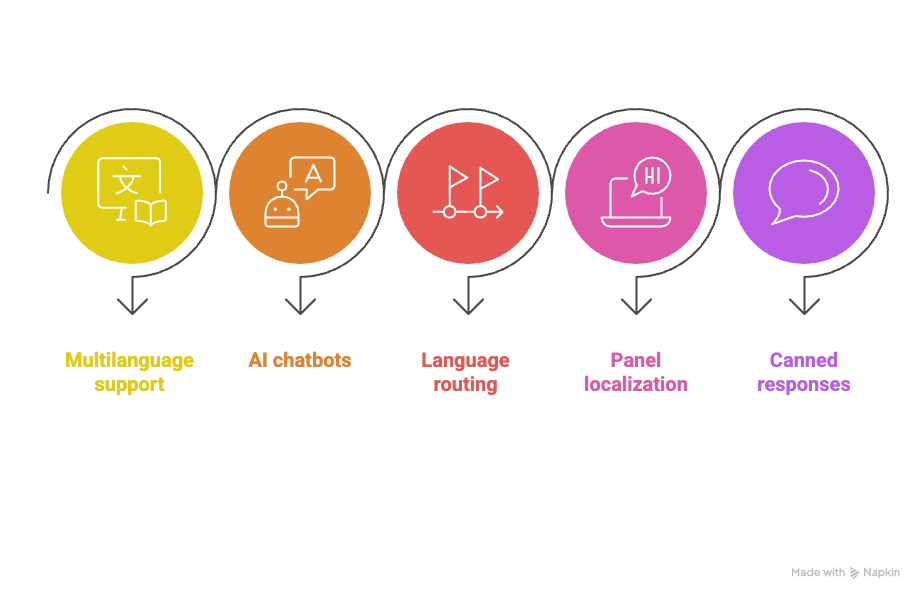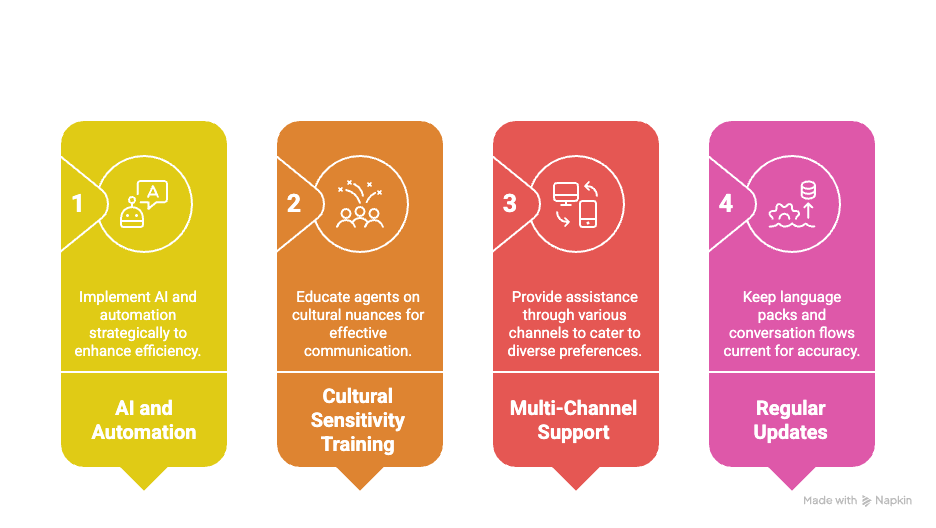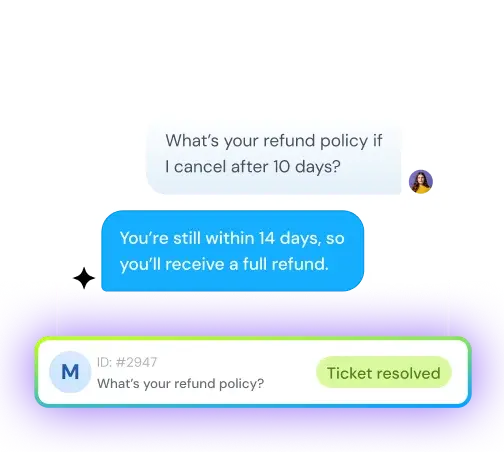Why your business needs multilingual live chat in 2025 [Expert guide]
Vaishali Jayaprakash
Oct 06, 2025

Most consumers avoid English-only websites - 30% never make purchases, while 29% rarely do. Multilingual live chat helps businesses overcome this challenge by connecting with customers in their preferred language.
Companies lose valuable customers when they don't provide multilingual support. Customer loyalty increases dramatically when businesses communicate in their native language, with users showing greater commitment.
Let's explore everything about multilingual customer service in 2025. You'll find how it works, what features matter, and the best ways to connect with customers worldwide. Multilingual live chat has become crucial to propel development, whether you serve diverse local communities or expand globally.
The growing need for multilingual customer support
Language barriers cost businesses money in today's connected world. They're not just communication hurdles. Consumers feel left out when brands don't speak their language. Businesses lose real money when customers need support in their native tongue.
Globalization and customer expectations
Numbers tell the story clearly. Online shoppers overwhelmingly prefer to buy products with details in their native language. This isn't just a preference - it drives their buying decisions. On top of that, customers will likely buy again from brands that offer support in their language.
Different regions have unique service expectations:
- Japanese customers value "omotenashi" - complete dedication to service
- South Africans follow "Batho Pele" principles with emphasis on courtesy
- Eastern Europeans see service as purely business-focused
- French customers need quick answers
- British consumers are happy with responding in lesser time
These cultural differences show why generic customer support fails globally. Good service means different things in different countries. Companies that understand these differences have an edge over competitors.
Multilingual live chat plays a key role as customers expect smooth support everywhere. Native language support leads to happier customers who stick around longer.
Language barriers in digital communication
Unresolved problems pile up when customers can't explain their issues clearly. This communication gap breeds frustration. Trust breaks down. Sales suffer and customer loyalty fades.
Picture this: a customer struggles to explain a technical problem in their second language. They're stressed needlessly. Support agents might miss the real issue entirely. The problem takes longer to fix. Customer satisfaction drops and they might not come back.
Live chat should be quick and easy. Language barriers turn it into a headache for international customers without multilingual support.
Digital communication brings its own set of challenges beyond translation. Cultural subtleties, technical terms, and emotional context get lost with basic translation tools. This becomes even more critical with complex products where precise communication matters.
Multilingual live chat offers a practical solution to these challenges. It helps businesses deliver personalized, culturally-aware support at scale. Customer expectations keep rising worldwide. Companies that invest in speaking their customers' languages build stronger relationships and reach more markets.
How multilingual live chat works
Multilingual live chat uses intelligent technology to help conversations flow naturally between languages. This technology connects your business with customers worldwide by breaking down language barriers.
Automatic language detection
Modern multilingual chat systems recognize your customer's language without manual input. The technology works through multiple approaches:
- Message analysis - The system gets insights from customer messages (needing at least 10 characters) to determine the language with high confidence
- Browser settings - Chat systems detect the user's browser language priorities automatically
- Location-based detection - Some platforms use geographical location to make their original language assumptions
The system detects language the moment a customer starts chatting. This sets up natural communication from the start. A Spanish-speaking visitor who begins typing triggers the system to recognize Spanish and adapt - no language selection needed. Many systems can even detect when customers switch languages during conversations.
Real-time translation in chat
Real-time translation technology powers multilingual chat. The process works smoothly:
The system translates incoming foreign language messages to the agent's language instantly. When agents respond in their native language, the system converts their messages to the customer's language. This happens naturally within the chat window.
Modern translation systems do more than convert words. AI-powered tools understand context, idioms, and industry-specific terminology. Some solutions achieve up to 97% accuracy rates. This makes conversations feel natural rather than robotic.
The technology combines advanced machine translation engines with specialized AI. Business-grade solutions handle complex challenges unlike simple tools like Google translate:
- Brand-specific terminology
- Industry jargon
- Common slang
- Acronyms
- Misspellings
These sophisticated systems learn continuously. They improve from corrections and build custom glossaries that ensure accurate translations for your business needs.
Localized chat widgets and interfaces
A complete multilingual chat solution adapts the entire user interface to match the customer's language. The system includes:
- Chat widget localization - Visual elements like buttons, prompts, and pre-chat forms appear in the customer's preferred language. Spanish users see "Envíenos un mensaje" instead of "Message Us".
- Agent interfaces - Support panels let your team work in their preferred language while serving multilingual customers.
- Pre-translated responses - Many systems provide ready-made responses in multiple languages. This helps agents respond to common questions quickly without translation delays.
- Right-to-Left (RTL) support - Advanced platforms handle languages like Arabic and Hebrew that read right-to-left by changing the interface orientation.
The chat widget recognizes the visitor's browser language settings and adjusts automatically. Most systems also let customers choose their preferred language manually if needed.
These three core technologies - automatic detection, real-time translation, and interface localization - create exceptional experiences for customers and support teams alike. Your agents can work in their native language while supporting dozens of others. This breaks down communication barriers that previously limited global business growth.
Top 5 features to look for in a multilingual live chat solution

You need to evaluate key features carefully when selecting a multilingual live chat platform. Look beyond simple translation capabilities to find trailblazing solutions that provide a continuous connection for customers and agents alike.
Built-in multilanguage support
Complete multilanguage support covers the entire chat experience—not just message translation. The best solutions provide user interfaces that adapt completely to different languages throughout the customer trip. Your chat widget, proactive greetings and notifications should adapt seamlessly. A Spanish customer visiting a French website should see both website and chat interface switch to Spanish automatically. The platform should detect user priorities based on browser settings or location to create a personalized experience right away.
AI chatbots with translation
The latest multilingual solutions now come with AI-powered chatbots that can detect and respond in multiple languages without human intervention. These advanced systems:
- Automatically identify the customer's language from their first message
- Switch to the appropriate language immediately
- Provide 24/7 support across time zones
- Improve translation accuracy over time
Some platforms offer chatbots that support twelve languages including English, French, Italian, Spanish, Portuguese, and German. Advanced systems can translate your knowledge base content on demand. You won't need manual updates when adding new support articles. This feature lets businesses scale support globally without adding more staff proportionally.
Language-specific routing
Smart routing guides customers to agents who speak their language, which ensures smooth communication from the start. Interactive voice response (IVR) systems automatically connect customers with skilled representatives. Many companies use a "follow the sun" support model where issues move between offices in different time zones. This creates true 24/7 multilingual support. LimeBike uses this approach to provide continuous support in seven languages including English, Chinese, Spanish, German, and Russian.
Panel localization for agents
Your support team's experience with the platform matters too. Panel localization lets agents direct the admin dashboard in their preferred language. This increases efficiency and reduces misunderstandings. Each agent can customize their interface language without affecting other team members. Quality platforms offer this option in major languages such as English, German, French, Spanish, Italian, and Portuguese. Global teams working across multiple regions find this flexibility valuable.
Pre-translated canned responses
Template responses that are pre-translated save time and keep interactions consistent. Agents don't need to translate common replies manually. These prepared responses deliver clear, reliable information no matter which team member handles the conversation. Good systems organize these templates by language with tags that make them easy to find during chats. Teams can respond faster with fewer translation errors, which creates a better experience for everyone. Organizing responses by specific queries or departments ensures customers receive accurate, relevant information always.
4 Business benefits of multilingual live chat

Multilingual live chat support delivers measurable ROI that goes beyond convenience. Companies see real results in their performance metrics as language barriers disappear.
Wider customer reach
Native language support opens up new market opportunities. Studies show that 30% of consumers never buy from English-only sites, and another 29% rarely do. Your business can tap into previously inaccessible markets by breaking down language barriers.
Customers feel left out without multilingual support and often switch to competitors who speak their language.
Improved customer satisfaction
Customer satisfaction rises when people can interact in their preferred language. Consumers are likely to buy again from brands that offer support in their native language. Users feel more loyal to companies providing mother tongue support. Multilingual support creates goodwill even during product issues. Customers show more patience with problems when they can talk to support in their native language. This comfort level helps maintain relationships through tough service moments.
Faster issue resolution
Quick problem-solving becomes possible when communication barriers fall away. Both parties understand the situation better when customers explain issues in their preferred language, which leads to faster solutions. Teams can help more customers as interactions become shorter and more efficient.
Modern solutions can handle simple questions in seconds instead of the usual 10+ minutes needed for traditional support. Some systems can automatically resolve most of the standard questions.
Higher conversion rates
Better conversion rates might be the most compelling reason to add multilingual support.
Localized websites convert better than single-language sites. Businesses report higher conversion rates and more engagement from non-English speaking regions.
Clear communication builds trust and drives these improved numbers. Customers make confident buying decisions when they fully understand your products and services. A smoother sales experience without language barriers directly boosts your bottom line.
4 Best practices for multilingual live chat in 2025
Multilingual live chat needs more than just good technology to work well. Your customer support strategy must include careful planning and execution to maximize its potential.
Use AI and automation wisely
The right mix of AI and human interaction is vital for multilingual support that works. By 2029, advanced AI chatbots will handle up to 80% of customer interactions without human intervention. This lets human agents focus on complex cases. These systems should automatically detect languages by analyzing text patterns and syntax. Human oversight remains important to maintain quality and add empathy to conversations. Your chatbot interactions need end-to-end encryption to protect customer data in all languages.
Train agents in cultural sensitivity
Cultural differences often cause more misunderstandings than language barriers. Your agents need knowledge about cultural norms, communication styles, and hidden biases. The training should cover non-verbal cues that change by a lot between cultures. These cues can lead to confusion without proper understanding. After training, agents should communicate better with people of all backgrounds and spot hidden biases to create an inclusive environment.
Offer support across multiple channels
Your multilingual support should go beyond chat:
- Create self-service options like FAQs, knowledge bases, and community forums in multiple languages
- Make automated responses and IVR systems available in different languages
- Add language location features that change content based on browser settings or location
This approach gives complete support throughout the customer's experience. While software helps, note that people prefer human contact for difficult problems.
Regularly update language packs and flows
Languages keep evolving, and your translation systems should too. Create a glossary of terms with specific translations to keep your brand message consistent. Look at multilingual chatbot data to see how well conversations work in each language and find ways to improve. Use this evidence-based information to update your language packs with new terms, cultural elements, and regional expressions.
Key takeaways on multilingual live chat
Multilingual live chat has evolved from a nice-to-have feature to something businesses can't do without in today's global marketplace. It does more than just translate - it helps build real connections with customers around the world by bridging cultural gaps.
Businesses that don't offer support in multiple languages are losing customers fast. But, companies with multilingual support see their conversion rates jump by up and that directly boosts your profits.
Success with multilingual support in 2025 needs more than just good tech. Your business needs a smart approach that combines AI tools with human expertise, cultural awareness training, and a smooth experience on every channel.
Companies that welcome multilingual live chat set themselves up to win globally. Don't see it as just another cost. Multilingual support is a smart investment that pays off through new markets, loyal customers, and better sales numbers. The real question isn't whether you can afford multilingual chat - it's whether your business can survive without it.
Quick summary: Why your business needs multilingual live chat in 2025
In 2025, multilingual live chat has become a must-have for businesses aiming to connect with a global audience. Studies show that 30% of consumers never buy from English-only websites, while another 29% rarely do. By offering customer support in multiple languages, businesses can bridge communication gaps, improve trust, and increase conversions. Multilingual live chat works through three main components: automatic language detection, real-time translation, and localized interfaces. Modern systems instantly recognize a customer’s language through message analysis, browser settings, or location, enabling natural conversations from the start. Real-time translation allows agents to reply in their own language while customers see responses in theirs, maintaining accuracy and tone. Localized chat widgets further enhance the experience by adapting buttons, messages, and layouts to match cultural and linguistic preferences.
The best multilingual live chat solutions include built-in multilanguage support, AI-powered chatbots, language-specific routing, localized agent panels, and pre-translated canned responses. These features ensure smooth communication, consistent quality, and faster resolutions across regions. The benefits are measurable—businesses enjoy wider market reach, higher customer satisfaction, quicker issue resolution, and better conversion rates. Customers are more likely to stay loyal when they receive support in their native language.
To succeed, companies must balance automation with human empathy, train agents in cultural sensitivity, and regularly update language packs. In short, multilingual live chat is not just about translation—it’s about building meaningful, culturally aware connections that help businesses grow globally and strengthen customer loyalty in an increasingly diverse digital marketplace.
Frequently Asked Questions
Multilingual live chat is crucial because it allows businesses to connect with a global customer base. Consumers mostly never buy from English-only sites, while offering support in multiple languages can increase customer loyalty and boost conversions significantly.
Automatic language detection in multilingual chat systems uses message analysis, browser settings, and location-based detection to identify the customer's language instantly. This allows for seamless communication without requiring manual language selection.
Important features include built-in multilanguage support for the entire chat interface, AI chatbots with translation capabilities, language-specific routing, panel localization for agents, and pre-translated canned responses for quick and consistent communication.
Multilingual live chat significantly improves customer satisfaction. Consumers are more likely to purchase again from brands offering support in their native language, feeling more loyal to companies providing support in their mother tongue.
Best practices include using AI and automation wisely, training agents in cultural sensitivity, offering support across multiple channels, and regularly updating language packs and conversation flows. It's also crucial to balance automated systems with human touch for complex issues.
